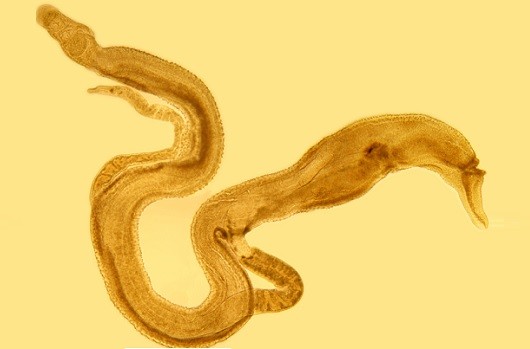Targeting unusual DNA structures against parasitic diseases
 Paired male and female adult schistosomes. They are typically 1 cm long. Credit: J. Keiser, CH.
Paired male and female adult schistosomes. They are typically 1 cm long. Credit: J. Keiser, CH.
The DNA double helix that makes up the genome of living organisms is a quasi-iconic structure in biology, formed by two intertwined strands of four paired nucleic bases: adenine binding to thymine, and cytosine binding to guanine. However, both DNA and single-stranded RNA can sometimes adopt unusual configurations. "The most common are called G-quadruplexes. They form a knot-like structure in the genome that can be problematic for the cell if it cannot get rid of them," explains Jean-Louis Mergny, Inserm researcher at the Optics and Biosciences Laboratory (LOB*) and specialist in these unusual nucleic acid structures. These structures are present in all organisms, including humans, and are thought to play a role in SARS-CoV-2 infection.
The recent sequencing of the genome of parasitic worms among the helminths, such as schistosomes, gave Jean-Louis Mergny the idea to investigate them together with specialists in bioinformatics, chemistry and parasitology. These worms are responsible for neglected tropical diseases such as schistosomiasis (also known as bilharzia), which infects an estimated 200 million people worldwide and is carried by ticks. "This infection is prevalent in Africa but is beginning to spread, and has been detected in Corsica," says Jean-Louis Mergny. A treatment already exists, but the parasite could become resistant to it. Targeting G-quadruplexes, which is already being considered in cancer and virology, could be a therapeutic option.
The main elementary patterns of G-quadruplexes are quartets of a single nucleic base, guanine (hence their name). In previous work, Jean-Louis Mergny and his colleagues developed a bioinformatics algorithm, G4 Hunter, which accurately identifies the sequences within genomes likely to form these G-quadruplexes. In this new study published in Nucleic Acids Research, they applied this tool to more than ten helminth species. These in silico results were also validated by in vitro experiments, in order to verify that the G-quadruplexes were indeed present in the cells.
Surprisingly, they found that the worm Ascaris lumbricoides in particular has a high level of very stable G-quadruplexes, without any deleterious effect. "We don't yet understand why. One hypothesis is that it has very efficient enzymes for untying its knots, even though they are extremely strong. We intend to continue investigating," continues the researcher.
The second important result is that the team found small molecules, called ligands, that are able to bind specifically to the G-quadruplexes of Schistosoma mansoni, stabilising these noxious structures by acting as a kind of glue that prevents the cell from untying these knots. The results show that some of these molecules have an antiparasitic activity as effective as the reference treatment on the adult form of the worm, and even more effective on the larval form.
Numerous constraints still need to be overcome before a treatment can be developed, and the next step would be to test these molecules in an animal model infected with Schistosoma mansoni. In addition, other ligand molecules will be tested, with the aim of identifying even more effective ones. Finally, there are fundamental biological questions to be answered, on the one hand to learn how certain worms can withstand the presence of extremely strong knots, and on the other hand to understand how genomes have evolved to become enriched or depleted in G-quadruplexes.
>Read the scientific publication
*LOB: a joint research unit CNRS, École Polytechnique - Institut Polytechnique de Paris, Inserm








